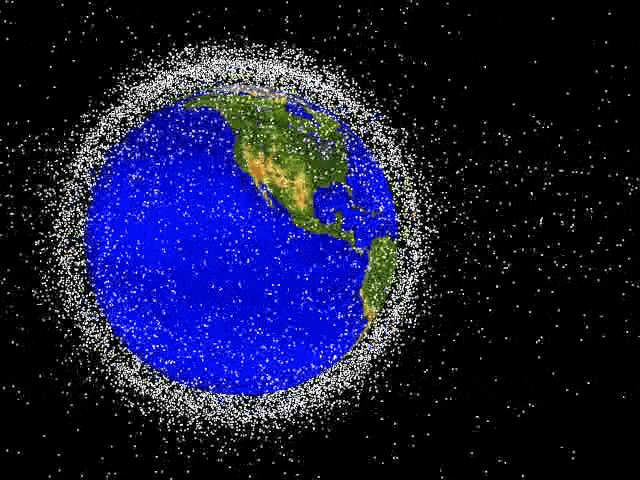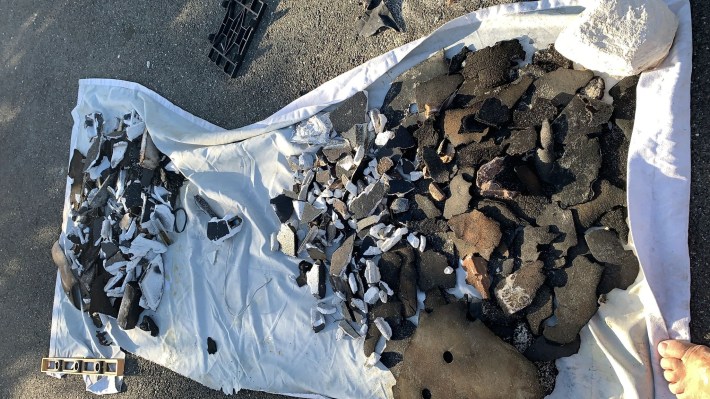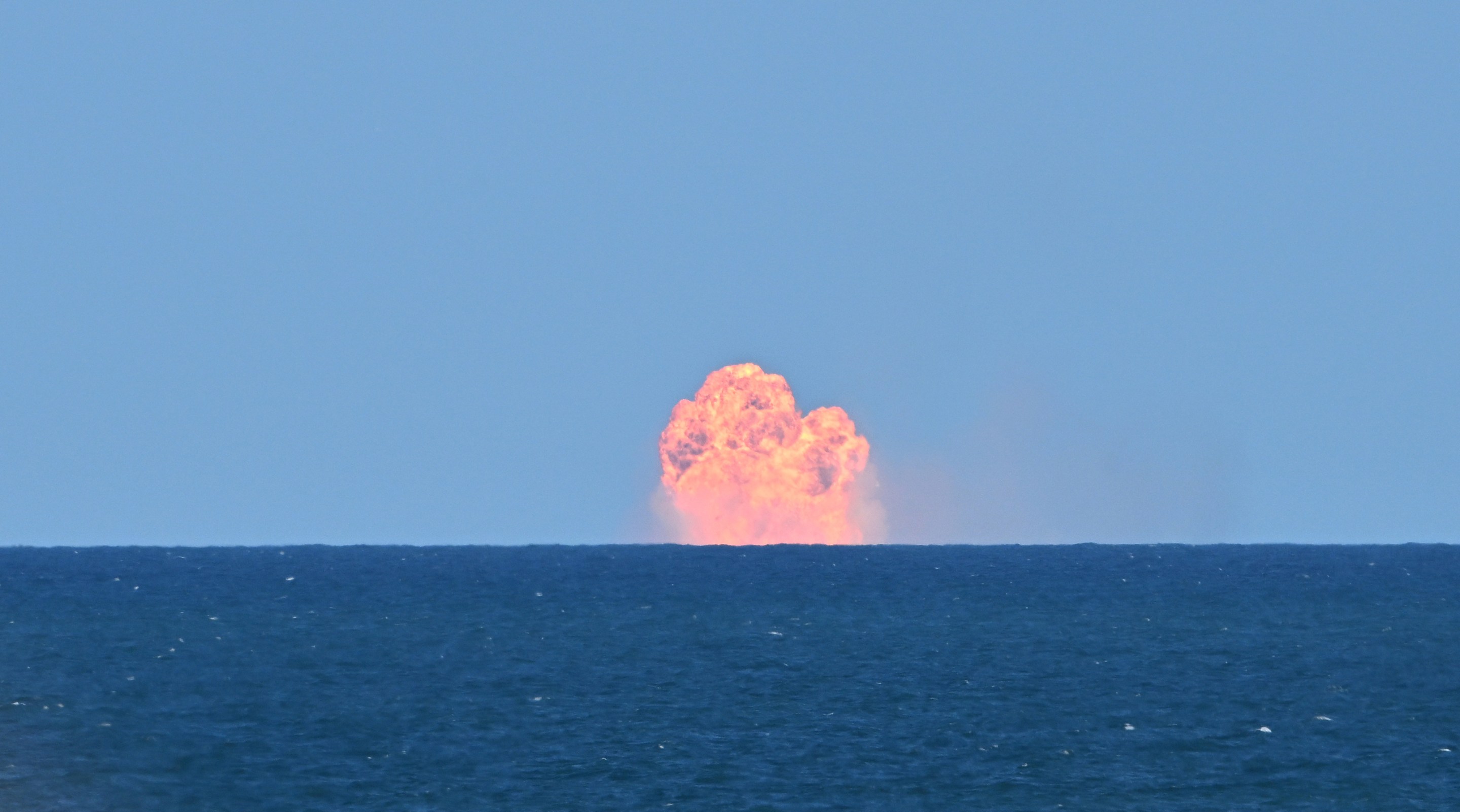Alizee Zimmermann and her husband were rinsing off their dive gear on a relatively muggy January evening when the sky exploded with a dozen shimmering fireballs. “We saw the trails as it started to lose control,” Zimmermann told me. “Then we heard the booms.”
The explosion prematurely ended SpaceX’s seventh test flight of its Starship rocket, sending pieces of the mammoth launch vehicle over the Turks and Caicos. Air traffic controllers diverted dozens of flights to avoid superheated chunks of falling rocketry. In the weeks following the faulty rocket test, volunteers with the nonprofit Turks & Caicos Reef Fund documented over 100 pounds of debris fragments that washed ashore. “People are very upset about it,” said Zimmermann, the executive director of the organization. “It's all over the beaches and in the seagrasses now.”
Just seven weeks later, the company’s eighth test flight of its megarocket met a similarly explosive fate, with the rain of debris visible from Turks and Caicos, the Bahamas, and Jamaica. No property damage or injuries were reported after the upper portion of the rocket broke up into smithereens over the Atlantic. SpaceX’s team left the Bahamas after determining that large pieces of the wreckage, including the engine, are likely in deep water and unrecoverable.

These back-to-back incidents are striking examples of a little discussed but widespread phenomenon: Sending ever more rockets into space is leaving a mark on our blue marble.
“Human activity in space is ubiquitous enough that it really is starting to have a significant environmental impact,” said Jonathan McDowell, an astrophysicist who tracks space launches at Harvard’s Smithsonian Astrophysical Observatory. After all, what goes up must come down.
After the Starship test flights exploded over the Caribbean, SpaceX released statements saying “there were no hazardous materials present in the debris and no significant impacts expected to occur to marine species or water quality.” But just how space debris impacts the marine environment is a woefully understudied area, according to Britta Baechler, director of ocean plastics research at Ocean Conservancy. A 2017 study from New Zealand concluded that potential contaminants and disturbance to marine life are major factors in the overall environmental risk of launch debris.
“Dumping trash in the ocean, whether it's space junk or whether it's single-use plastics, almost always has unforeseen consequences,” Baechler said.
Since the very first Sputnik launch back in 1957, humanity has surrounded Earth with space junk— human-made objects like expended rocket bodies and decommissioned satellites. After more than half a century of launching objects to space, there are now over 35,000 pieces of tracked objects hurtling around our planet at some 17,000 miles per hour, according to the European Space Agency.

Earth orbit is only getting more crowded: In 2024, over 2,800 objects were launched into space, according to the UN, breaking a record set in 2023. So much junk is filling Earth’s orbit that the collision risk potentially threatens our effort to explore the cosmos. But space junk is a problem for more than just space. Smaller objects re-entering Earth’s atmosphere mostly burn up due to friction in the upper atmosphere. (This in itself can be a problem, as studies suggest it could contribute to ozone depletion.) Bigger pieces of material, however, regularly survive the fall back to Earth and land in significant chunks.
Spacecraft have been deliberately ditched over the Earth’s oceans for decades. One section of the South Pacific, centered on the farthest point from land, has been the watery grave for hundreds of spacecraft artifacts. Fittingly known as the Spacecraft Cemetery, some of the cosmic corpses found here include the Soviet-era Mir space station and China's Tiangong-1 prototype. The International Space Station—humanity’s only inhabited outpost in space until Tiangong launched in 2021—is expected to splash-land at this remote spot by the end of 2030.
Scheduled re-entries over the ocean don’t always go according to plan. In 1979, NASA attempted to crash Skylab—the agency’s first space station—into the Indian Ocean. Miscalculations hurled portions of the space station over parts of the Australian desert. According to NASA, the field of debris stretched 2,450 miles.
In 2022, researchers calculated that there is a 10 percent chance someone will be killed by falling space debris within a decade. “As the rate of space traffic increases, the risk increases,” McDowell said. “At some point our luck will run out.”
For objects coming back from orbit, experts can model and predict how much debris survives reentry and where it’ll likely land. But when rockets explode during flight—like the seventh and eighth test flight of SpaceX’s Starship—the debris field is largely based on the whims of gravity.
“The manner in which we're conducting space operations where we have these failures that are spreading debris in the oceans and populated areas—that's a concern,” Moriba Jah, an astrodynamicist and space environmentalist, told me. “We let mother nature figure it out, and it's difficult to predict what nature is going to do.”
There's no easy fix. Some ambitious orbit-cleaning tech proposals that have cropped up include debris-capturing harpoons and orbital street sweepers. For now, though, the best way to limit debris is for spacefaring countries and companies to opt for safe and sustainable practices—choosing controlled reentry for defunct objects, and limiting the numbers of satellites launched into orbit. Both would go against the profit-conscious culture that has become increasingly common in rocketry as the private industry swells.
Jah, for one, thinks of space debris as a waste management issue rather than a business one: “Orbital space should be considered a finite resource,” he said, “and it should be considered an environment that is in need of constant preservation.”
Regulating space trash is complicated. The Outer Space Treaty, developed in the 1960s and signed by all major spacefaring nations, says countries will be “liable for damage caused by their space objects” and will “avoid harmful contamination of space and celestial bodies.” In the eyes of the law, whatever country launched the debris is responsible for it. But there's no international body that can actively enforce this.
“The United States government would be liable for anything that Elon [Musk] is doing,” Jah said. “There are international courts where things could be pursued, but it's really up to each country to come up with its own space laws and enforce it on their own citizens and the people that they license to operate in space.”
The United States launches more rockets and satellites into space than any other country, and most come from a single company: Elon Musk’s SpaceX. How government agencies like the Federal Aviation Administration deal with the environmental risks of space launches will likely set the course for other spacefaring nations. While SpaceX agreed to environmental conditions from the FAA, Musk now claims the agency is too risk-averse and stifles exploration with burdensome regulation: “The fundamental problem is that humanity will forever be confined to Earth unless there is radical reform at the FAA!” Musk tweeted last year. SpaceX and the Federal Aviation Administration did not immediately respond to a request for comment.

Musk’s outsized role in the White House further complicates things; the odds of this administration cracking down on his companies feels slight. “Historically, any given domain that has experienced exploration has always been led or preceded by the wealthiest,” Jah noted. “Now with space, it's no different. It's the wealthiest people making decisions that the rest of us have to live with, to the detriment of the environment.”
Already, SpaceX has landed in hot water due to environmental concerns at its Boca Chica, Texas, launch facility. One 2024 investigation from the New York Times found the company’s operations there caused fires, powerful explosions, and other problems that can cause environmental damage on at least 19 occasions since 2019. SpaceX has redesigned some of the rocket parts that damaged the surrounding area.
This week, the FAA closed its investigation into SpaceX’s seventh test flight. It identified 11 corrective actions that were implemented before they attempted an eighth launch, which also broke up. The investigation surrounding that incident remains open, potentially grounding Starship until it’s deemed safe to the public.
Back in the Turks and Caicos, Zimmermann was still finding debris along the southern coastline in late March, months after they fell from the sky. Some locals are selling these found bits of rocket junk, like black heat shield tiles shed during travel, in places like Ebay or Etsy. You may want to wait for prices to come down—these collectibles get less rare every day.







